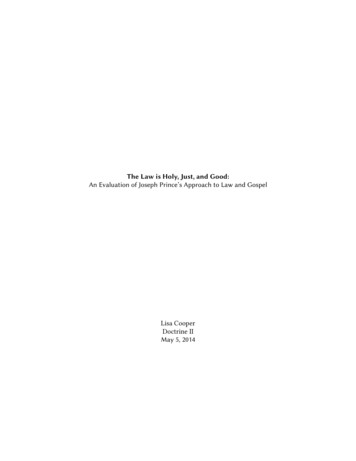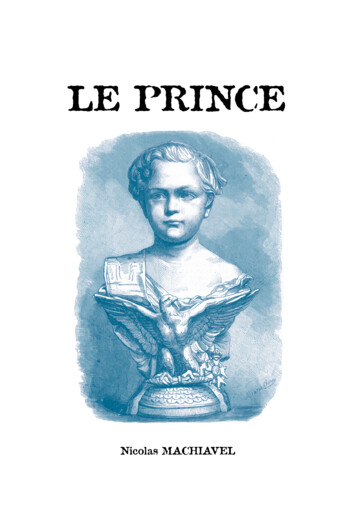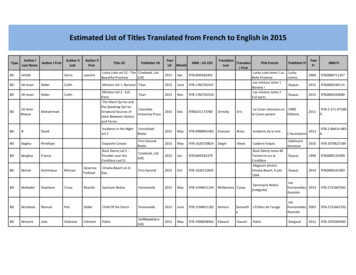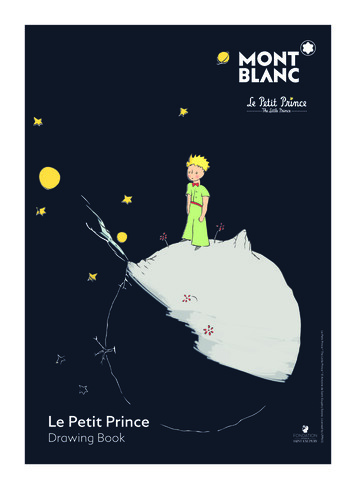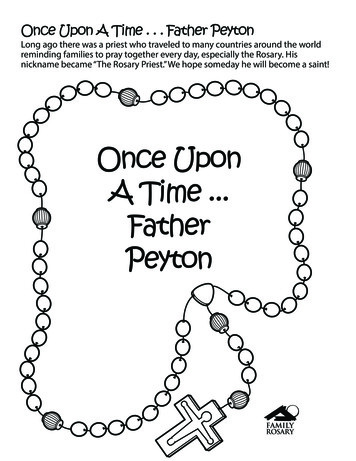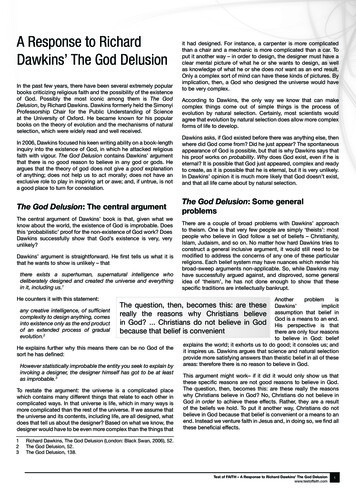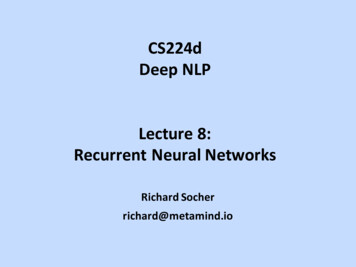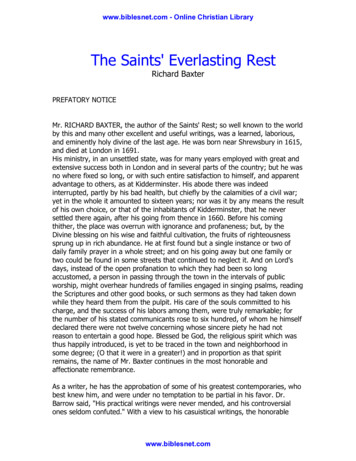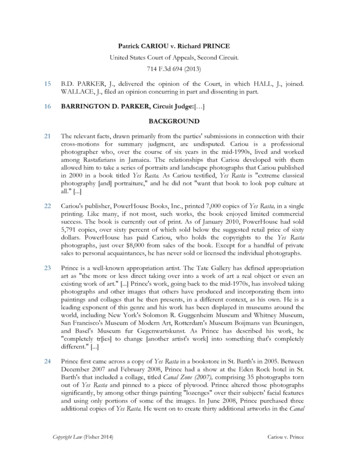
Transcription
Patrick CARIOU v. Richard PRINCEUnited States Court of Appeals, Second Circuit.714 F.3d 694 (2013)15B.D. PARKER, J., delivered the opinion of the Court, in which HALL, J., joined.WALLACE, J., filed an opinion concurring in part and dissenting in part.16BARRINGTON D. PARKER, Circuit Judge:[ ]BACKGROUND21The relevant facts, drawn primarily from the parties' submissions in connection with theircross-motions for summary judgment, are undisputed. Cariou is a professionalphotographer who, over the course of six years in the mid-1990s, lived and workedamong Rastafarians in Jamaica. The relationships that Cariou developed with themallowed him to take a series of portraits and landscape photographs that Cariou publishedin 2000 in a book titled Yes Rasta. As Cariou testified, Yes Rasta is "extreme classicalphotography [and] portraiture," and he did not "want that book to look pop culture atall." [.]22Cariou's publisher, PowerHouse Books, Inc., printed 7,000 copies of Yes Rasta, in a singleprinting. Like many, if not most, such works, the book enjoyed limited commercialsuccess. The book is currently out of print. As of January 2010, PowerHouse had sold5,791 copies, over sixty percent of which sold below the suggested retail price of sixtydollars. PowerHouse has paid Cariou, who holds the copyrights to the Yes Rastaphotographs, just over 8,000 from sales of the book. Except for a handful of privatesales to personal acquaintances, he has never sold or licensed the individual photographs.23Prince is a well-known appropriation artist. The Tate Gallery has defined appropriationart as "the more or less direct taking over into a work of art a real object or even anexisting work of art." [.] Prince's work, going back to the mid-1970s, has involved takingphotographs and other images that others have produced and incorporating them intopaintings and collages that he then presents, in a different context, as his own. He is aleading exponent of this genre and his work has been displayed in museums around theworld, including New York's Solomon R. Guggenheim Museum and Whitney Museum,San Francisco's Museum of Modern Art, Rotterdam's Museum Boijmans van Beuningen,and Basel's Museum fur Gegenwartskunst. As Prince has described his work, he"completely tr[ies] to change [another artist's work] into something that's completelydifferent." [.]24Prince first came across a copy of Yes Rasta in a bookstore in St. Barth's in 2005. BetweenDecember 2007 and February 2008, Prince had a show at the Eden Rock hotel in St.Barth's that included a collage, titled Canal Zone (2007), comprising 35 photographs tornout of Yes Rasta and pinned to a piece of plywood. Prince altered those photographssignificantly, by among other things painting "lozenges" over their subjects' facial featuresand using only portions of some of the images. In June 2008, Prince purchased threeadditional copies of Yes Rasta. He went on to create thirty additional artworks in the CanalCopyright Law (Fisher 2014)Cariou v. Prince
Zone series, twenty-nine of which incorporated partial or whole images from Yes Rasta.[4]The portions of Yes Rasta [.] photographs used, and the amount of each artwork thatthey constitute, vary significantly from piece to piece. In certain works, such as JamesBrown Disco Ball, Prince affixed headshots from Yes Rasta onto other appropriated images,all of which Prince placed on a canvas that he had painted. In these, Cariou's work isalmost entirely obscured. The Prince artworks also incorporate photographs that havebeen enlarged or tinted, and incorporate photographs appropriated from artists otherthan Cariou as well. Yes Rasta is a book of photographs measuring approximately 9.5″ 12″. Prince's artworks, in contrast, comprise inkjet printing and acrylic paint, as well aspasted-on elements, and are several times that size. For instance, Graduation measures 723/4″ 52 1/2″ and James Brown Disco Ball 100 1/2″ 104 1/2″. The smallest of thePrince artworks measures 40″ 30″, or approximately ten times as large as each page ofYes Rasta.25Patrick Cariou, Photographs from Yes Rasta, pp. 11, 59 [.]Copyright Law (Fisher 2014)Cariou v. Prince
27Richard Prince, James Brown Disco Ball28In other works, such as Graduation, Cariou's original work is readily apparent: Prince didlittle more than paint blue lozenges over the subject's eyes and mouth, and paste a pictureof a guitar over the subject's body.[.]Copyright Law (Fisher 2014)Cariou v. Prince
30Patrick Cariou, Photograph from Yes Rasta, p. 118 [.]Copyright Law (Fisher 2014)Cariou v. Prince
32Richard Prince, Graduation33Between November 8 and December 20, 2008, the Gallery put on a show featuringtwenty-two of Prince's Canal Zone artworks, and also published and sold an exhibitioncatalog from the show. The catalog included all of the Canal Zone artworks (includingCopyright Law (Fisher 2014)Cariou v. Prince
those not in the Gagosian show) except for one, as well as, among other things,photographs showing Yes Rasta photographs in Prince's studio. Prince never sought orreceived permission from Cariou to use his photographs.34Prior to the Gagosian show, in late August, 2008, a gallery owner named Cristiane Cellecontacted Cariou and asked if he would be interested in discussing the possibility of anexhibit in New York City. Celle did not mention Yes Rasta, but did express interest inphotographs Cariou took of surfers, which he published in 1998 in the aptly titled Surfers.Cariou responded that Surfers would be republished in 2008, and inquired whether Cellemight also be interested in a book Cariou had recently completed on gypsies. The twosubsequently met and discussed Cariou's exhibiting work in Celle's gallery, includingprints from Yes Rasta. They did not select a date or photographs to exhibit, nor [.] didthey finalize any other details about the possible future show.35At some point during the Canal Zone show at Gagosian, Celle learned that Cariou'sphotographs were "in the show with Richard Prince." Celle then phoned Cariou and,when he did not respond, Celle mistakenly concluded that he was "doing something withRichard Prince. [Maybe] he's not pursuing me because he's doing something better,bigger with this person. [H]e didn't want to tell the French girl I'm not doing it with you,you know, because we had started a relation and that would have been bad." [.] At thatpoint, Celle decided that she would not put on a "Rasta show" because it had been "donealready," and that any future Cariou exhibition she put on would be of photographs fromSurfers. Celle remained interested in exhibiting prints from Surfers, but Cariou neverfollowed through.36According to Cariou, he learned about the Gagosian Canal Zone show from Celle inDecember 2008. On December 30, 2008, he sued Prince, the Gagosian Gallery, andLawrence Gagosian, raising claims of copyright infringement. [.] The defendantsasserted a fair use defense, arguing that Prince's artworks are transformative of Cariou'sphotographs and, accordingly, do not violate Cariou's copyrights. [.] Ruling on theparties' subsequently-filed cross-motions for summary judgment, the district court (Batts,J.) "impose[d] a requirement that the new work in some way comment on, relate to thehistorical context of, or critically refer back to the original works" in order to be qualify asfair use, and stated that "Prince's Paintings are transformative only to the extent that theycomment on the Photos." [.] The court concluded that "Prince did not intend tocomment on Cariou, on Cariou's Photos, or on aspects of popular culture closelyassociated with Cariou or the Photos when he appropriated the Photos," [.] and for thatreason rejected the defendants' fair use defense and granted summary judgment to Cariou.The district court also granted sweeping injunctive relief, ordering the defendants to"deliver up for impounding, destruction, or other disposition, as [Cariou] determines, allinfringing copies of the Photographs, including the Paintings and unsold copies of theCanal Zone exhibition book, in their possession." [.][5] This appeal followed.Copyright Law (Fisher 2014)Cariou v. Prince
DISCUSSIONI.39We review a grant of summary judgment de novo. [.] The well known standards forsummary judgment set forth in Rule 56(c) apply. [.] "Although fair use is a mixedquestion of law and fact, this court has on numerous occasions resolved fair usedeterminations at the summary judgment stage where . there are no genuine issues ofmaterial fact." [.] This case lends itself to that approach.II.41The purpose of the copyright law is "[t]o promote the Progress of Science and usefulArts." U.S. Const., Art. I, § 8, cl. 8. As Judge Pierre Leval of this court has explained,"[t]he copyright is not an inevitable, divine, or natural right that confers on authors theabsolute ownership of their creations. It is designed rather to stimulate activity andprogress in the arts for the intellectual enrichment of the public." Pierre N. Leval, Towarda Fair Use Standard, 103 Harv. L.Rev. 1105, 1107 (1990) (hereinafter "Leval"). Fair use is"necessary to fulfill [that] very purpose." Campbell, 510 U.S. at 575[.]. Because" excessively broad protection would stifle, rather than advance, the law's objective,'" fairuse doctrine "mediates between" "the property rights [copyright law] establishes increative works, which must be protected up to a point, and the ability of authors, artists,and the rest of us to express them — or ourselves by reference to the works of others,which must be protected up to a point." [.]42The doctrine was codified in the Copyright Act of 1976, which lists four non-exclusivefactors that must be considered in determining fair use. Under the statute,43[T]he fair use of a copyrighted work . for purposes such as criticism, comment,news reporting, teaching (including multiple copies for classroom use), scholarship,or research, is not an infringement of copyright. In determining whether the usemade of a work in any particular case is a fair use the factors to be considered shallinclude —44(1) the purpose and character of the use, including whether such use is of acommercial nature or is for nonprofit educational purposes;45(2) the nature of the copyrighted work;46(3) the amount and substantiality of the portion used in relation to the copyrightedwork as a whole; and47(4) the effect of the use upon the potential market for or value of the copyrightedwork.4817 U.S.C. § 107. As the statute indicates, and as the Supreme Court and our court haverecognized, the fair use determination is an open-ended and context-sensitive inquiry. [.]The statute "employs the terms including' and such as' in the preamble paragraph toindicate the illustrative and not limitative function of the examples given, which thusCopyright Law (Fisher 2014)Cariou v. Prince
provide only general guidance about the sorts of copying that courts and Congress mostcommonly had found to be fair uses." [.] The "ultimate test of fair use . is whether thecopyright law's goal of promoting the Progress of Science and useful Arts' . would bebetter served by allowing the use than by preventing it." [.]49The first statutory factor to consider, which addresses the manner in which the copiedwork is used, is "[t]he heart of the fair use inquiry." [.] We ask50whether the new work merely supersedes the objects' of the original creation, orinstead adds something new, with a further purpose or different character, alteringthe first with new expression, meaning, or message[,] . in other words, whetherand to what extent the new work is transformative. [T]ransformative works . lieat the heart of [706] the fair use doctrine's guarantee of breathing space.51Campbell, 510 U.S. at 579[.]. "If the secondary use adds value to the original — if [theoriginal work] is used as raw material, transformed in the creation of new information,new aesthetics, new insights and understandings — this is the very type of activity thatthe fair use doctrine intends to protect for the enrichment of society.'" [.] For a use to befair, it "must be productive and must employ the quoted matter in a different manner orfor a different purpose from the original." [.]52The district court imposed a requirement that, to qualify for a fair use defense, asecondary use must "comment on, relate to the historical context of, or critically referback to the original works." [.] Certainly, many types of fair use, such as satire andparody, invariably comment on an original work and/or on popular culture. For example,the rap group 2 Live Crew's parody of Roy Orbison's "Oh, Pretty Woman" "was clearlyintended to ridicule the white-bread original." [.] Much of Andy Warhol's work,including work incorporating appropriated images of Campbell's soup cans or of MarilynMonroe, comments on consumer culture and explores the relationship between celebrityculture and advertising. As even Cariou concedes, however, the district court's legalpremise was not correct. The law imposes no requirement that a work comment on theoriginal or its author in order to be considered transformative, and a secondary work mayconstitute a fair use even if it serves some purpose other than those (criticism, comment,news reporting, teaching, scholarship, and research) identified in the preamble to thestatute. [.] Instead, as the Supreme Court as well as decisions from our court haveemphasized, to qualify as a fair use, a new work generally must alter the original with"new expression, meaning, or message." Campbell, 510 U.S. at 579, 114 S.Ct. 1164; see alsoBlanch, 467 F.3d at 253 (original must be employed "in the creation of new information,new aesthetics, new insights and understandings" [.]); Castle Rock, 150 F.3d at 142.53Here, our observation of Prince's artworks themselves convinces us of the transformativenature of all but five, which we discuss separately below. These twenty-five of Prince'sartworks manifest an entirely different aesthetic from Cariou's photographs. WhereCariou's serene and deliberately composed portraits and landscape photographs depictthe natural beauty of Rastafarians and their surrounding environs, Prince's crude andjarring works, on the other hand, are hectic and provocative. Cariou's black-and-whitephotographs were printed in a 9 1/2″ 12″ book. Prince has created collages on canvasthat incorporate color, feature distorted human and other forms and settings, andCopyright Law (Fisher 2014)Cariou v. Prince
measure between ten and nearly a hundred times the size of the photographs. Prince'scomposition, presentation, scale, color palette, and media are fundamentally different andnew compared to the photographs, as is the expressive nature of Prince's work. [.]54Prince's deposition testimony further demonstrates his drastically different approach andaesthetic from Cariou's. Prince testified that he "[doesn't] have any really interest in what[another artist's] [.] original intent is because . what I do is I completely try to change itinto something that's completely different. I'm trying to make a kind of fantastic,absolutely hip, up to date, contemporary take on the music scene." [.] As the districtcourt determined, Prince's Canal Zone artworks relate to a "post-apocalyptic screenplay"Prince had planned, and "emphasize themes [of Prince's planned screenplay] of equalityof the sexes; highlight the three relationships in the world, which are men and women,men and men, and women and women'; and portray a contemporary take on the musicscene." [.]55The district court based its conclusion that Prince's work is not transformative in largepart on Prince's deposition testimony that he "do[es]n't really have a message," that hewas not "trying to create anything with a new meaning or a new message," and that he"do[es]n't have any . interest in [Cariou's] original intent." [.] On appeal, Cariou arguesthat we must hold Prince to his testimony and that we are not to consider how Prince'sworks may reasonably be perceived unless Prince claims that they were satire or parody.No such rule exists, and we do not analyze satire or parody differently from any othertransformative use.56It is not surprising that, when transformative use is at issue, the alleged infringer would goto great lengths to explain and defend his use as transformative. Prince did not do so here.However, the fact that Prince did not provide those sorts of explanations in hisdeposition — which might have lent strong support to his defense — is not dispositive.What is critical is how the work in question appears to the reasonable observer, notsimply what an artist might say about a particular piece or body of work. Prince's workcould be transformative even without commenting on Cariou's work or on culture, andeven without Prince's stated intention to do so. Rather than confining our inquiry toPrince's explanations of his artworks, we instead examine how the artworks may"reasonably be perceived" in order to assess their transformative nature. Campbell, 510 U.S.at 582[.]; Leibovitz v. Paramount Pictures Corp., 137 F.3d 109, 113-14 (2d Cir.1998)(evaluating parodic nature of advertisement in light of how it "may reasonably beperceived"). The focus of our infringement analysis is primarily on the Prince artworksthemselves, and we see twenty-five of them as transformative as a matter of law.[.]58Here, looking at the artworks and the photographs side-by-side, we conclude [.] thatPrince's images, except for those we discuss separately below, have a different character,give Cariou's photographs a new expression, and employ new aesthetics with creative andcommunicative results distinct from Cariou's. Our conclusion should not be taken tosuggest, however, that any cosmetic changes to the photographs would necessarilyconstitute fair use. A secondary work may modify the original without beingtransformative. For instance, a derivative work that merely presents the same material butin a new form, such as a book of synopses of televisions shows, is not transformative. SeeCastle Rock, 150 F.3d at 143; Twin Peaks Prods., Inc. v. Publ'ns Int'l, Ltd., 996 F.2d 1366, 1378Copyright Law (Fisher 2014)Cariou v. Prince
(2d Cir.1993). In twenty-five of his artworks, Prince has not presented the same materialas Cariou in a different manner, but instead has "add[ed] something new" and presentedimages with a fundamentally different aesthetic. [.]59The first fair use factor — the purpose and character of the use — also requires that weconsider whether the allegedly infringing work has a commercial or nonprofit educationalpurpose. [.] That being said, "nearly all of the illustrative uses listed in the preambleparagraph of § 107, including news reporting, comment, criticism, teaching, scholarship,and research. are generally conducted for profit." [.] "The commercial/nonprofitdichotomy concerns the unfairness that arises when a secondary user makes unauthorizeduse of copyrighted material to capture significant revenues as a direct consequence ofcopying the original work." [.] This factor must be applied with caution because, as theSupreme Court has recognized, Congress "could not have intended" a rule thatcommercial uses are presumptively unfair. [.] Instead, "[t]he more transformative thenew work, the less will be the significance of other factors, like commercialism, that mayweigh against a finding of fair use." [.] Although there is no question that Prince'sartworks are commercial, we do not place much significance on that fact due to thetransformative nature of the work.60We turn next to the fourth statutory factor, the effect of the secondary use upon thepotential market for the value of the copyrighted work, because such discussion furtherdemonstrates the significant differences between Prince's work, generally, and Cariou's.Much of the district court's conclusion that Prince and Gagosian infringed on Cariou'scopyrights was apparently driven by the fact that Celle decided not to host a Yes Rastashow at her gallery once she learned of the Gagosian Canal Zone show. The district courtdetermined that this factor weighs against Prince because he "has unfairly damaged boththe actual and potential markets for Cariou's original work and the potential market forderivative use licenses for Cariou's original work." [.]61Contrary to the district court's conclusion, the application of this factor does not focusprincipally on the question of damage to Cariou's derivative market. We have made clearthat "our concern is not whether the secondary use suppresses or even destroys themarket for the original work or its potential derivatives, but whether the secondary useusurps the market of the original work." Blanch, 467 F.3d at 258 (quotation marks omitted)(emphasis added); NXIVM Corp. v. Ross Inst., 364 F.3d 471, 481-82 (2d Cir.2004). "Themarket for potential derivative uses [.] includes only those that creators of original workswould in general develop or license others to develop." [.] Our court has concluded thatan accused infringer has usurped the market for copyrighted works, including thederivative market, where the infringer's target audience and the nature of the infringingcontent is the same as the original. For instance, a book of trivia about the televisionshow Seinfeld usurped the show's market because the trivia book "substitute[d] for aderivative market that a television program copyright owner . would in general developor license others to develop." [.] Conducting this analysis, we are mindful that "[t]hemore transformative the secondary use, the less likelihood that the secondary usesubstitutes for the original," even though "the fair use, being transformative, might wellharm, or even destroy, the market for the original." [.]Copyright Law (Fisher 2014)Cariou v. Prince
62As discussed above, Celle did not decide against putting on a Yes Rasta show because ithad already been done at Gagosian, but rather because she mistakenly believed thatCariou had collaborated with Prince on the Gagosian show. Although certain of Prince'sartworks contain significant portions of certain of Cariou's photographs, neither Princenor the Canal Zone show usurped the market for those photographs. Prince's audience isvery different from Cariou's, and there is no evidence that Prince's work ever touched —much less usurped — either the primary or derivative market for Cariou's work. There isnothing in the record to suggest that Cariou would ever develop or license secondary usesof his work in the vein of Prince's artworks. Nor does anything in the record suggest thatPrince's artworks had any impact on the marketing of the photographs. Indeed, Cariouhas not aggressively marketed his work, and has earned just over 8,000 in royalties fromYes Rasta since its publication. He has sold four prints from the book, and only topersonal acquaintances.63Prince's work appeals to an entirely different sort of collector than Cariou's. Certain ofthe Canal Zone artworks have sold for two million or more dollars. The invitation list for adinner that Gagosian hosted in conjunction with the opening of the Canal Zone showincluded a number of the wealthy and famous such as the musicians Jay-Z and BeyonceKnowles, artists Damien Hirst and Jeff Koons, professional football player Tom Brady,model Gisele Bundchen, Vanity Fair editor Graydon Carter, Vogue editor Anna Wintour,authors Jonathan Franzen and Candace Bushnell, and actors Robert DeNiro, AngelinaJolie, and Brad Pitt. Prince sold eight artworks for a total of 10,480,000, and exchangedseven others for works by painter Larry Rivers and by sculptor Richard Serra. Cariou onthe other hand has not actively marketed his work or sold work for significant sums, andnothing in the record suggests that anyone will not now purchase Cariou's work, orderivative non-transformative works (whether Cariou's own or licensed by him) as aresult of the market space that Prince's work has taken up. This fair use factor thereforeweighs in Prince's favor.64The next statutory factor that we consider, the nature of the copyrighted work, "calls forrecognition that some works are closer to the core of intended copyright protection thanothers, with the consequence that fair use is more difficult to establish when the formerworks are copied." [.] We consider " (1) whether the work is expressive or creative, .with a greater leeway being allowed to a claim of fair use where the work is factual orinformational, [.] and (2) whether the work is published or unpublished, with the scopefor fair use involving unpublished works being considerably narrower.'" [.]65Here, there is no dispute that Cariou's work is creative and published. Accordingly, thisfactor weighs against a fair use determination. However, just as with the commercialcharacter of Prince's work, this factor "may be of limited usefulness where," as here, "thecreative work of art is being used for a transformative purpose." [.]66The final factor that we consider in our fair use inquiry is "the amount and substantialityof the portion used in relation to the copyrighted work as a whole." 17 U.S.C. § 107(3).We ask "whether the quantity and value of the materials used[] are reasonable in relationto the purpose of the copying." [.] In other words, we consider the proportion of theoriginal work used, and not how much of the secondary work comprises the original.Copyright Law (Fisher 2014)Cariou v. Prince
67Many of Prince's works use Cariou's photographs, in particular the portrait of thedreadlocked Rastafarian at page 118 of Yes Rasta, the Rastafarian on a burro at pages 83to 84, and the dreadlocked and bearded Rastafarian at page 108, in whole or substantialpart. In some works, such as Charlie Company, Prince did not alter the source photographvery much at all. In others, such as Djuana Barnes, Natalie Barney, Renee Vivien and RomaineBrooks take over the Guanahani, the entire source photograph is used but is also heavilyobscured and altered to the point that Cariou's original is barely recognizable. Although"[n]either our court nor any of our sister circuits has ever ruled that the copying of anentire work favors fair use[,]. courts have concluded that such copying does notnecessarily weigh against fair use because copying the entirety of a work is sometimesnecessary to make a fair use of the image." [.] "[T]he third-factor inquiry must take intoaccount that the extent of permissible copying varies with the purpose and character ofthe use." [.]68The district court determined that Prince's "taking was substantially greater thannecessary." [.] We are not clear as to how the district court could arrive at such aconclusion. In any event, the law does not require that the secondary artist may take nomore than is necessary. [.] We consider not only the quantity of the materials taken butalso "their quality and importance" to the original work. [.] The secondary use "must be[permitted] to conjure up' at least enough of the original" to fulfill its transformativepurpose. [.] Prince used key portions of certain of Cariou's photographs. In doing that,however, we determine that in twenty-five of his artworks, Prince transformed thosephotographs into something new and different and, as a result, this factor weighs heavilyin Prince's favor.69As indicated above, there are five artworks that, upon our review, present closerquestions. Specifically, Graduation, Meditation, Canal Zone (2008), Canal Zone (2007), andCharlie Company do not sufficiently differ from the photographs of Cariou's that theyincorporate for us confidently to make a determination about their [.] transformativenature as a matter of law. Although the minimal alterations that Prince made in thoseinstances moved the work in a different direction from Cariou's classical portraiture andlandscape photos, we can not say with certainty at this point whether those artworkspresent a "new expression, meaning, or message." [.]70Certainly, there are key differences in those artworks compared to the photographs theyincorporate. Graduation, for instance, is tinted blue, and the jungle background is in softerfocus than in Cariou's original. Lozenges painted over the subject's eyes and mouth — analteration that appears frequently throughout the Canal Zone artworks — make the subjectappear anonymous, rather than as the strong individual who appears in the original.Along with the enlarged hands and electric guitar that Prince pasted onto his canvas,those alterations create the impression that the subject is not quite human. Cariou'sphotograph, on the other hand, presents a human being in his natural habitat, lookingintently ahead. Where the photograph presents someone comfortably at home in nature,Graduation combines divergent elements to create a sense of discomfort. However, wecannot say for sure whether Graduation constitutes fair use or whether Prince hastransformed Cariou's work enough to render it transformative.Copyright Law (Fisher 2014)Cariou v. Prince
71We have the same concerns with Meditation, Canal Zone (2007), Canal Zone (2008), andCharlie Company. Each of those artworks differs from, but is still similar in key aestheticways, to Cariou's photographs. In Meditation, Prince again added lozenges and a guitar tothe same photograph that he incorporated into Graduation, this time cutting the subjectout of his background, switching the direction he is facing, and taping that image onto ablank canvas. In Canal Zone (2007), Prince created a gridded collage using 31 differentphotographs of Cariou's, many of them in whole or significant part, with alterations ofsome of those photographs limited to lozenges or cartoonish appendages painted ordrawn on. Canal Zone (2008) incorporates six photographs of Cariou's in whole or in part,including the s
24 Prince first came across a copy of Yes Rasta in a bookstore in St. Barth's in 2005. Between December 2007 and February 2008, Prince had a show at the Eden Rock hotel in St. Barth's that included a collage, titled Canal Zone (2007), comprising 35 photographs torn out of Yes Rasta and pinned to a piece of plywood. Prince altered those photographs
